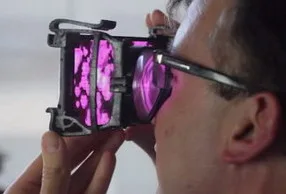Wearality Corporation, a Silicon Valley start-up, has started a Kickstarter campaign to raise $100,000 to finance production of its head-mounted Virtual Reality (VR) system called the Wearality Sky. As of April 8th, the company has pledges for $23,907 from 266 backers, with 26 days left on its campaign. Since the Kickstarter campaign is only a few days old, it seems likely the company will meet its goal.
The Wearality Sky is an opto-mechanical system that fits a 5” or 6” high resolution cell phone such as the Samsung Galaxy Note, iPhone 6+ and Nexus 6. As such, it has several competitors in the very low cost VR market. Wearality co-founder and COO Gunnar Wieboldt discussed the advantages of the Wearality Sky system over its competitors and other HMDs in a four minute YouTube video that is also posted on the company website.
 Wearality Sky. Left, with smartphone; Center, folded for storage; Right, in use.
Wearality Sky. Left, with smartphone; Center, folded for storage; Right, in use.
One of the major claimed advantages of the Wearality Sky is its field of view (FOV), 150°, which is said to nearly match the FOV of human vision. According to Wearality, a cell phone at typical viewing distance provides about a 10° FOV, a tablet provides a 25° FOV, a laptop a 45° FOV, a flat screen TV a 60° FOV, a movie theater a 75° FOV, competitor HMDs typically provide a FOV in the range of 90° – 100° and an Imax theater provides a 110° FOV. Reality doesn’t really look like reality if only a portion of your FOV is covered by the image, so the larger the FOV the better, at least in terms of VR.
This wide FOV is achieved by a curved Fresnel lens that wraps around the eye. According to Wearality, the Fresnel lens provides a very large pupil box. This eliminates the need for things like interpupillary adjustment, focus adjustment or special adaptors for people wearing glasses. Of course, if your glasses don’t provide a 150° FOV (mine don’t), then you will see what you see in reality: a focused image where you look through your glasses and the peripheral image where you do not look through your glasses will be out of focus.
This Fresnel lens optically maps the left and right images on the split screen to the 150° FOV of the left and right eyes for a 3D image. Note that, strictly speaking, the Wearality Sky is not a head-mounted device because it does not mount on the head – the user holds it there. This hand held nature of the Wearality Sky, coupled with a large pupil box, is cited as an advantage by Wieboldt. He says it makes it easy to pass the unit around in a group and share the VR images. For gamers or other longer term uses, the Sky provides clips to allow it to mount to the brim of a hat.
One potential issue with the Wearality Sky is the issue of pixelization. A high resolution cell phone is intended to be pixel free, when used at a FOV of 10° When half of the pixels on the screen are spread over a 150° FOV, I would expect them to be clearly visible. Whether this is an issue or not remains to be seen. I can only say I found it to be a major issue with the lower resolution Oculus Rift HMD when I saw a demo of that. Perhaps the higher resolution of modern cell phones will solve the problem.
One of the key elements of any VR system is software and content. Wieboldt mentions this while going into few specifics in his video. Wearality Sky is said to work with Cardboard, Unity, Unreal and Unigine development tools and the apps developed with these platforms.
The basic technology of the Wearality Sky was originally developed over a five year period at Lockheed Martin for the defense and aerospace industry. The development team formed a separate company, exclusively licensed the intellectual property from Lockheed Martin and is now translating the technology into commercial products. The company says the Sky is the first of many VR products the public can expect from Wearality. – Matthew Brennesholtz

